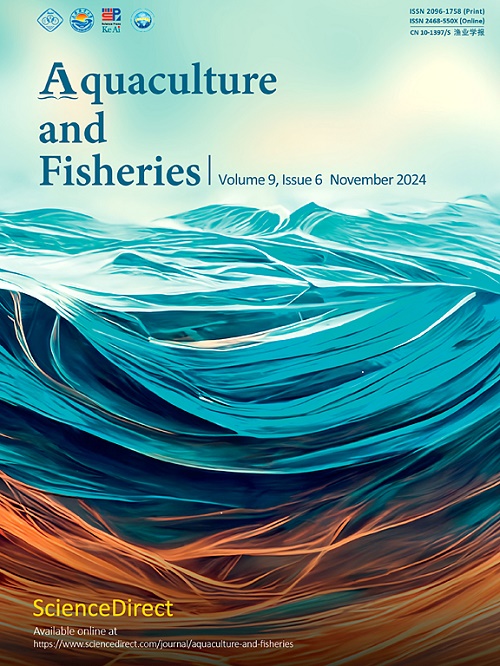Ecological stoichiometric of C, N and P of Coilia species
Q1 Agricultural and Biological Sciences
引用次数: 0
Abstract
Fish of the Coilia genus play a crucial ecological role by serving as a vital link between marine and freshwater ecosystems. To gain a comprehensive understanding of the ecological patterns, intra-interspecific variations, and potential determinants of Coilia from an ecological stoichiometry perspective, analyzed the concentrations of C, N, and P elements in various types of Coilia, including C. nasus, C. mystus, C. grayii, C. brachygnathus, and C. nasus taihuensis, across the Yangtze River basin. The result shows that: 1) A broad spectrum of eco-stoichiometric patterns within Coilia species, facilitating their adaptation to diverse ecosystems, including seawater and freshwater. Specifically, the C content in Coilia species from 40% to 70%, while N% and P% range between 4%–12% and 0.5%–3%, respectively. 2) Intriguingly, interspecific variations in eco-stoichiometric patterns are predominantly driven by anadromous populations. The anadromous Coilia species, including C. nasus, C. mystus, and C. grayii, exhibit significantly higher C contents and C/N, C/P, and N/P ratios compared to their landlocked and freshwater counterparts (C. nasus taihuensis and C. brachygnathus). However, the trends in N and P content are reversed. 3) Intraspecific differences vary among Coilia species, notably observed in C. nasus taihuensis and C. brachygnathus, where there's minimal correlation with body size. Conversely, C. nasus and C. mystus demonstrate a substantial influence of body size, with increasing fish size associated with higher C content, C/N, C/P, and N/P ratios, while N and P content decrease. This suggests that larger fishes store more energy (C%) in preparation for reproductive migration. In conclusion, this study provides a scientific foundation for comprehending the ecological patterns and intra-interspecific variations in Coilia. Furthermore, it contributes to the application of ecological chemometrics in the study of migratory fish, enriching our understanding of the intricate dynamics within this ecologically significant species.
纤毛虫物种的碳、氮、磷生态计量学
Coilia属鱼类作为海洋和淡水生态系统之间的重要纽带,发挥着至关重要的生态作用。为了从生态化学计量学的角度全面了解卷毛的生态格局、种间变异及其潜在的决定因素,本文分析了长江流域不同类型卷毛(C. nasus)、C. mystus、C. grayii、C. brachygnathus和C. nasus taihuensis)中C、N、P元素的浓度。结果表明:1)扇贝物种具有广谱的生态化学计量模式,有利于其适应海水和淡水等不同生态系统;其中,Coilia种C含量在40% ~ 70%之间,N%和P%分别在4% ~ 12%和0.5% ~ 3%之间。2)有趣的是,生态化学计量模式的种间变化主要是由雌雄同体种群驱动的。与内陆和淡水品种(C. nasus taihuensis和C. brachygnathus)相比,溯河蝽、C. mystus和C. grayii的C含量、C/N、C/P和N/P显著高于内陆和淡水品种(C. nasus taihuensis和C. brachygnathus)。然而,氮、磷含量的变化趋势是相反的。3)种内差异存在差异,特别是在C. nasus taihuensis和C. brachygnathus中,其与体型的相关性很小。相反,鱼体大小对鼻鼻草和墨鱼的影响较大,鱼体大小越大,鱼体内碳含量、碳氮比、碳磷比和氮磷比越高,而氮磷含量越低。这表明较大的鱼类储存更多的能量(C%)为繁殖迁徙做准备。本研究为进一步了解稻属植物的生态格局和种间变异提供了科学依据。此外,它有助于生态化学计量学在洄游鱼类研究中的应用,丰富我们对这一具有重要生态意义的物种内部复杂动态的理解。
本文章由计算机程序翻译,如有差异,请以英文原文为准。
求助全文
约1分钟内获得全文
求助全文
来源期刊

Aquaculture and Fisheries
Agricultural and Biological Sciences-Aquatic Science
CiteScore
7.50
自引率
0.00%
发文量
54
审稿时长
48 days
期刊介绍:
 求助内容:
求助内容: 应助结果提醒方式:
应助结果提醒方式:


